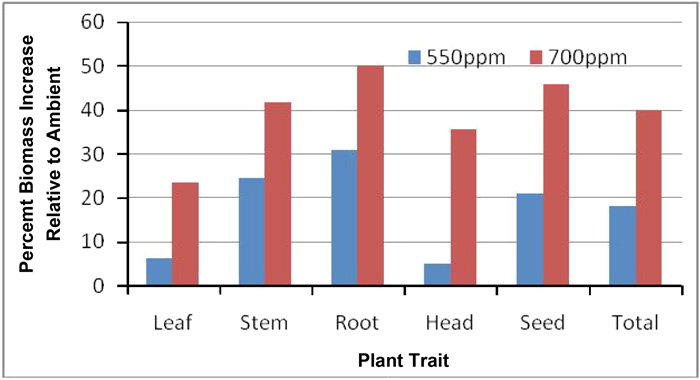| Follow @co2science |
Paper Reviewed
Lakshmi, N.J., Vanaja, M., Yadav, S.K., Maheswari, M., Archana, G., Patil, A and Srinivasarao, C. 2017. Effect of CO2 on growth, seed yield and nitrogen uptake in sunflower. Journal of Agrometeorology 19: 195-199.
In a recent study, Lakshmi et al. (2017) set out to evaluate the impact of elevated CO2 on the growth, seed yield and nitrogen uptake of sunflower (Helianthus annus L. Hybrid KBSH-1), which is one of the top 35 crops in terms of global food production. This work was conducted at the Central Research Institute for Dryland Agriculture in Telangana, India, where plants were grown from seed in pots in open-top chambers under three atmospheric CO2 concentrations (380, 550 or 700 ppm). All treatments received adequate fertilizer.
So what did their study reveal?
As shown in the figure below, results of the experiment indicated that elevated CO2 led to enhancements in leaf, stem, root, head and seed biomass, leading to an overall 18.7 and 40.5 percent stimulation in total plant biomass in the 550 and 700 ppm CO2 treatments, respectively. Seed yield, which is perhaps the most important measure for agricultural production, experienced similar increases of 21 and 46 percent at 550 and 700 ppm CO2. Another benefit was found in the oil yield of the sunflower plants, which rose by 21 percent (g per plant) in the 550 ppm treatment and by 51 percent in the 700 ppm CO2 treatment.
Other significant findings were noted in plant nitrogen (N) dynamics, where Lakshmi et al. report that "although high CO2 levels tended to lower N concentration in some plant parts, elevated CO2 enhanced total N accumulation in each plant component via an increase in biomass." What is more, the seven researchers further note that both physiological N use efficiency (g biomass per g N uptake) and grain N use efficiency (g grain per g N uptake) were higher under elevated CO2 compared to ambient. And as a result of these findings, they report that the nitrogen harvest index, "considered to be a measure of how efficiently the plant utilizes acquired nitrogen for the production of grain protein (seed nitrogen to total shoot nitrogen) was similar for ambient and elevated CO2 conditions," indicating that despite a decrease in N concentration, the sunflower plants were able to effectively redistribute acquired N from leaves and stems into grains.
All things considered, therefore, it would appear that those who grow and those who consume sunflower products will reap significant benefits from the CO2-induced enhancements documented here, as the air's CO2 content continues to rise in the future.

Figure 1. Percent increase in leaf, stem, root, head, seed and total biomass of sunflower plants grown at 550 and 700 ppm CO2, relative to plants grown under ambient (380 ppm) CO2 conditions. Source: Lakshmi et al. (2017).




